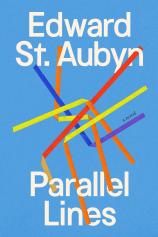Parallel Lines
Review
Parallel Lines
British novelist Edward St. Aubyn is best known for his five Patrick Melrose books. In PARALLEL LINES, he has returned to some of the characters featured in his 2021 novel, DOUBLE BLIND. Readers already attracted to St. Aubyn for his elegant prose and psychological acuity will be pleased with his latest. Many of those encountering him for the first time likely will seek out more of his work after reading this empathetic family drama seasoned with just the appropriate amount of thoughtful humor.
The novel is set in post-COVID London and features a cast of almost exclusively highly educated and verbally facile characters. The main person outside that privileged circle is Sebastian Tanner, who thinks of himself as an “ambulatory schizophrenic” after wrapping up two months in a psychiatric hospital following a suicide attempt and is about to enter a halfway house. For most of his life, Sebastian has been obsessed with finding his “Bio Mum,” the woman who gave him up for adoption at 18 months, after doing the same for his twin sister at birth.
Sebastian’s twin, Olivia, lives with her husband, Francis, and their four-year-old son, Noah. The latter is preternaturally bright and obsessed with dinosaurs as he works with Francis to construct his own version of an ark at their rural home. His mother is “working on the end of the world,” producing a series of BBC radio programs on extinction events (asteroids are first), while his father is employed by an NGO dedicated to saving Amazonian rainforest from the depredations of an American oil company.
"St. Aubyn closes the book with a scene that suggests he’s not finished with Sebastian, Olivia and some of these other characters. If that’s the case, we can only hope that the wait for their return won’t be a lengthy one."
Rather than teasing the reader with questions of whether (and, if so, how) Olivia and Sebastian will discover that they’re siblings, St. Aubyn dispenses with that mystery relatively early in the novel. As a result, the main drama centers on how Martin Carr, Olivia’s adoptive father who learns of the family connection only after he’s been working as Sebastian’s psychoanalyst for five years, will honor his ethical duties without causing irreparable damage to the person he considers “my most vulnerable patient.”
Much of the novel’s plot plays out in entertaining conversational set pieces, like the dinner where Martin and his wife, Lizzie (also a psychiatrist), dissect British and American politics in the age of Brexit and Donald Trump with Olivia and Francis. Debating the ethics of psychological professionals opining on politicians’ mental status, Olivia muses on whether it would be better “if the words ‘narcissist’ and ‘sociopath’ entered the general vocabulary with real explanatory power rather than just being grandiose alternatives to ‘wanker’ or ‘jerk’.”
But it isn’t only in scenes of witty table talk that St. Aubyn displays a delight with clever repartee. Sebastian’s struggles with mental illness don’t prevent him from holding his own in his interactions with the other characters. At an art gallery event, his responses to verbal cues even persuade the gallery owner that he’s an art critic capable of writing a catalog essay. St. Aubyn relies both on Sebastian’s words and his interior monologue to create a sympathetic portrait of someone with a troubled mind simply trying to make his way in the world.
St. Aubyn’s preoccupations extend beyond the problems of his fictional creations. Art becomes a dominant subject, and one of the persistent themes is the phenomenon of light in a world that’s darkening with ecological collapse and political unrest. It’s manifest in the considerable attention he devotes to the work of prominent American perceptual artist James Turrell, including references to actual pieces featured at the fictional gallery show that’s the focus of much of the novel’s second half.
In the real world, Turrell has fashioned numerous installations he calls “Skyspaces” --- specially lighted rooms with an opening to the sky --- and St. Aubyn imagines one at the Big Sur home of technology mogul Hunter Sterling. Sterling sold his business to an “amortality company” that “exploited the fear of death by offering to download its customers’ consciousness onto a ‘non-biological substrate’” and now searches for something that will give his life meaning as his wife, Lucy, faces her cancer diagnosis.
The novel’s other light artist is Helio, an aide at Sebastian’s psychiatric hospital who’s trying to get his foot on the first step of the ladder where Turrell occupies the top rung. The show also provides St. Aubyn with an opportunity to flex his descriptive muscle, as he pictures the gallery that “now looked like the Intergalactic Bar in Star Wars, an indistinct hubbub full of jabbering aliens, a bubble and squeak of languages and cries, of wobbling jowls, and ribbed foreheads bulging with brains and Botox.”
PARALLEL LINES brings to mind some aspects of novels like Richard Powers’ THE OVERSTORY and PLAYGROUND, with their focus on environmentalism and technological change, and Jennifer Egan’s THE CANDY HOUSE, which explored the issue of human consciousness. These comparisons aren’t intended to detract from the originality of St. Aubyn’s work, but instead suggest the impressive literary company in which he’s operating and the skill with which he marries fictional and real worlds.
St. Aubyn closes the book with a scene that suggests he’s not finished with Sebastian, Olivia and some of these other characters. If that’s the case, we can only hope that the wait for their return won’t be a lengthy one.
Reviewed by Harvey Freedenberg on June 28, 2025
Parallel Lines
- Publication Date: June 3, 2025
- Genres: Fiction
- Hardcover: 272 pages
- Publisher: Knopf
- ISBN-10: 0593535340
- ISBN-13: 9780593535349




